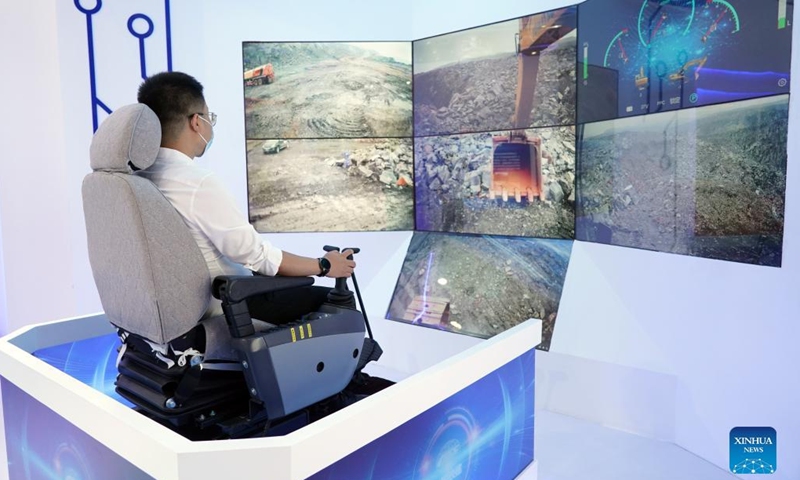China’s robotics industry has attained remarkable and substantive achievements in recent years, and is expected to catch up with that of developed countries like Japan with less time than imaged thanks to new technologies like artificial intelligence (AI) and big data, officials and experts said during the 2022 World Robot Conference (WRC) concluded on Sunday.
Chinese robotics enterprises have made phased breakthroughs in core components such as precision decelerators, high-performance servo motors and new-type sensors, while progress has also been made in core software represented by the robot operating system and has entered into practical application, Xin Guobin, vice minister of the Ministry of Industry and Information Technology, said at the WRC.
During the four-day event held in Beijing, many Chinese companies, including specialized robot firms and traditional manufacturing giants, showcased their latest technologies and products.
Hangzhou-based Unitree Robotics attracted widespread attention as the company staged a performance involving 130 Go1 robot dogs. “The performance is only a form to showcase our robot dogs, through which customers can learn more about our products,” the company told the Global Times on Sunday, noting that Unitree has been speeding up to create more application scenarios for the robots, not only in the industrial end but also entering daily lives.
According to the company, the servo motors, decelerators, controllers and most of the sensors of its quadruped robots have all achieved independent research and development. The company said that it has applied for more than 100 patents and has more than 80 licensed patents.
“China’s robotics sector has formed a complete industrial chain, though there is still gap between China and advanced countries like Japan in core components such as servo motors – an electrical device that rotate parts of robots with high efficiency and precision – and decelerators,” Liu Gang, director of the Nankai Institute of Economics and chief economist at the Chinese Institute of New Generation AI Development Strategies, told the Global Times on Sunday.
With the emergence of new technologies like AI and big data, it would take less time for China to catch up with these nations, he said, noting that China may even overtake them like how China’s electric vehicle industry overtook Japan.
China released the 14th Five-Year Plan for the Robotics Industry in December, aiming to make the country a global center of excellence for robotics technology innovation, advanced manufacturing and integrated applications by 2025.
Currently, the self-reliance rate of making certain robots has reached 90 percent, and domestic companies’ competitiveness is greatly improved with lower costs. In addition to robotics firms, domestic traditional manufacturing companies like home appliance maker Gree Electric Appliances have been engaged in the R&D of robots for smart manufacturing within its factories, contributing to the advance of robotics technologies in a variety of scenarios, Liu said.
Domestic AI firm Beijing OrionStar Technology Co takes the lead in the industry to put forward the formula of “AI + software + hardware + service = robot.” Its self-researched AI technology covers intelligent voice and face recognition algorithm, indoor navigation algorithm as well as cloud big data algorithm. In addition, based on Android, they have created a full self-research navigation technology and Robot OS open system.
OrionStar told the Global Times that Chinese service robots have great potential to lead the world, as the country is recognized as enjoying the most complete supply chain systems in the world.
Moreover, China has advantages in talent with a broad talent pool, with the internet industry nurturing a large cohort of world-class engineers, product managers and digital technologists, which also contributed to the country’s advantage in various aspects such as big data and AI, the company noted.
In spite of a complex international environment, global robotics enterprises accelerated opening-up and cooperation, with the robotics industrial and supply chain further integrated. In 2021, some leading robotics multinationals such as Fanuc, Yaskawa and ABB announced to step up R&D and production in China to better integrate into the market, Xin said.
“China welcomes global investors to invest in and grow their business in the country and benefit from the country’s business opportunities,” he stressed, noting that China will continue to encourage robotics enterprises, institutions and organizations at home and abroad to form innovation and supply chain partnerships to build open, stable and safe robotics industrial and supply chains.
China is the world’s largest market for the application of robots. The output of China’s industrial robots reached 366,000 units in 2021, up 68 percent on a yearly basis. The production of service robots in the country soared 49 percent year-on-year to 9.21 million units last year, according to data from the National Bureau of Statistics.
In the first half of this year, the total volume of disclosed financing in the robotics industry amounted to over 5 billion yuan ($733 million), mainly in key fields such as core parts, collaborative robots and surgery robots, official data showed.
(Global Times)




